Wildlife

Light pollution impacts nearly every living species. Learn more about specific ways ALAN harms different species:
There have also been negative impacts of ALAN observed in owls, foxes, and badgers (among many other species).
Migratory Birds
Many migrating bird species rely on environmental light cues for navigation.
Artificial light interferes with this behavior in two main ways: Positive phototaxis draws birds away from their migratory routes, and ALAN negatively impacts the distribution of birds along their migratory routes, making them fly higher than they would in more rural and less light-polluted areas.
Learn more about the effects of Positive Phototaxis:
Sea Turtles
Moths
According to Aaron Watson, moths (as well as other insects) are not attracted to light as many people believe; they are confused by it. Learn more about the impact of ALAN on moths and insects in Aaron's interview.
Dog Whelk
Stop video at 6:40
Pollinating Insects
Many different types of outdoor lighting have been found to negatively impact pollinating insects, including streetlights. Learn more about some of the effects of ALAN on pollinators.
Ecosystem Services
Ecosystem services are benefits that humans receive from the natural environment. Pollination of food crops by insects is an example of an ecosystem service that is crucial to human well-being. Light pollution disrupts this service, among others.
Nocturnal Pollinators
ALAN harms nocturnal pollinators. Direct impacts include reduced crop fields and population declines among pollinators, leading to what is known as an insect apocalypse.
Research Credits
Katie Joslyn • Class of 2024
State of the Rockies Project


